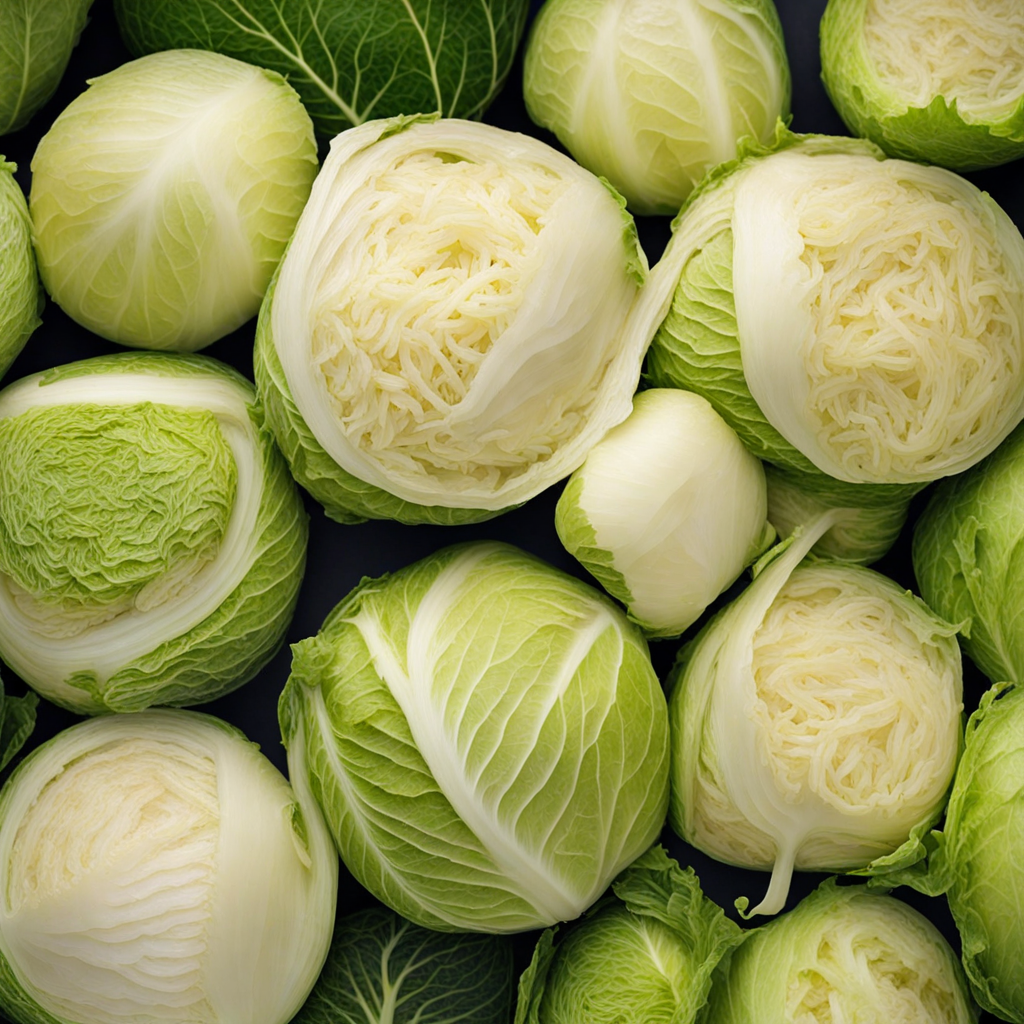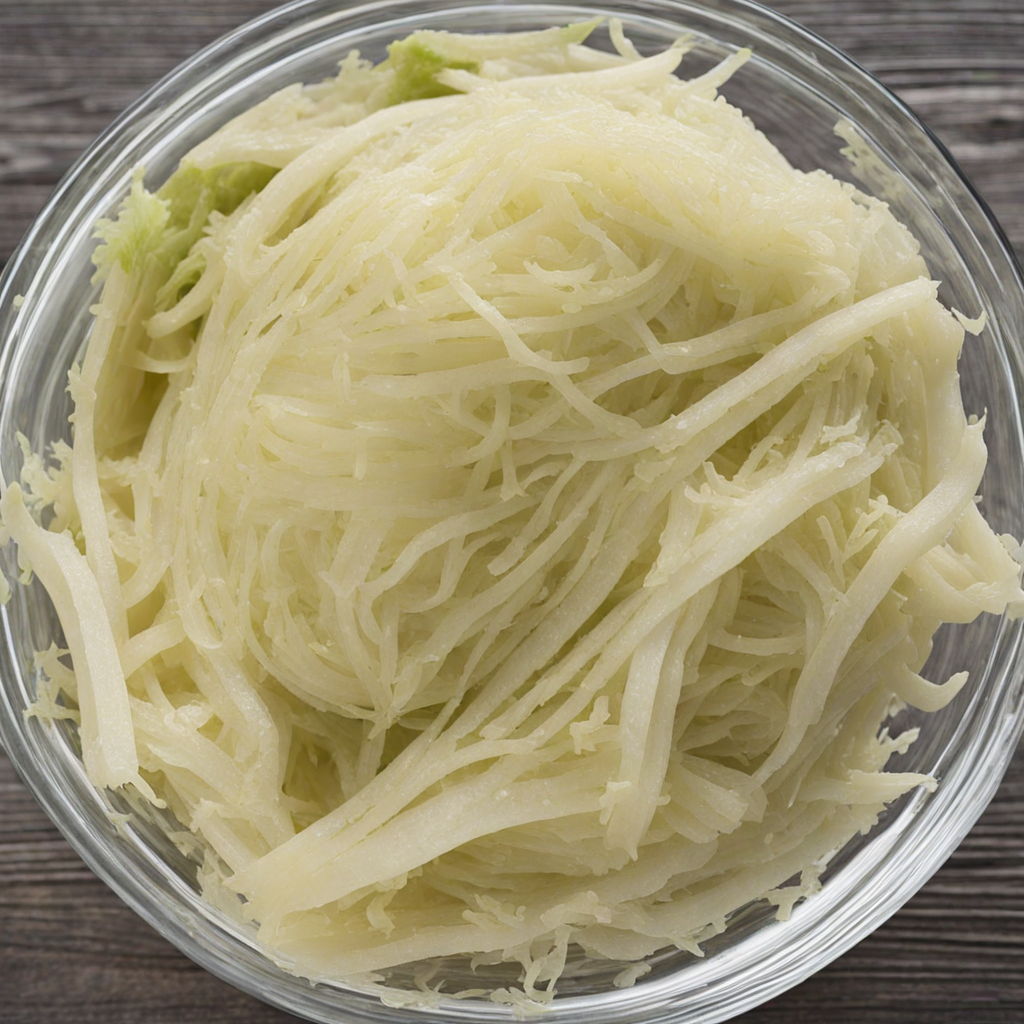Sauerkraut
Sauerkraut is a traditional German dish made from finely shredded fermented cabbage, renowned for its crisp texture and tangy flavor. The process of fermentation not only preserves the cabbage but also enhances its nutritional value, making it rich in probiotics, vitamins C and K. The result is a dish that offers a delightful crunch paired with a distinctive sourness that can elevate a variety of meals. This unique taste is the result of lactic acid bacteria breaking down the sugars in the cabbage, creating a complex flavor profile that ranges from mildly tart to intensely sour, depending on the fermentation time and conditions. Often served as a side dish, sauerkraut complements many staple German dishes such as sausages, pork, and potatoes, providing a refreshing contrast to the richness of these foods. Its acidity cuts through fatty flavors, making it a perfect palate cleanser. In addition to traditional pairings, sauerkraut can be incorporated into salads, sandwiches, and even gourmet dishes, showcasing its versatility in contemporary cooking. The vibrant color and lively taste make it not just a staple, but a celebration of German culinary heritage. For those adventurous enough to explore sauerkraut beyond the plate, it can be made at home using simple ingredients—shredded cabbage and salt—allowing for experimentation with spices and additional vegetables. Whether enjoyed straight from the jar, sautéed, or used as a topping, sauerkraut offers a unique sensory experience that can introduce new flavors to your palate. Its rich historical context, combined with its health benefits and complex flavor, makes sauerkraut a must-try for anyone looking to broaden their culinary horizons.
How It Became This Dish
The Tangy Tale of Sauerkraut: A Journey Through Time Sauerkraut, a dish synonymous with German cuisine, is more than just fermented cabbage; it embodies centuries of history, cultural significance, and adaptation. Its origins date back to ancient times, and its journey through history reflects the evolution of culinary practices, agricultural advancements, and the interplay of various cultures. #### Origins: Ancient Beginnings The story of sauerkraut begins long before it became a staple in German kitchens. Evidence suggests that the practice of fermenting cabbage originated in ancient China around 2000 BC. It is believed that laborers constructing the Great Wall of China consumed a version of fermented cabbage, which was preserved with rice wine. This method not only enhanced the flavor but also ensured the cabbage could be stored for extended periods, crucial for survival during harsh winters. The technique of fermentation traveled westward through trade routes, reaching Europe around the 4th century AD. The Romans encountered fermented cabbage during their conquests, and it quickly became popular across the empire. Roman soldiers valued it for its nutritional benefits, particularly its high vitamin C content, which helped prevent scurvy during long campaigns. #### The German Connection: Cultural Significance While sauerkraut’s roots may lie in Asia, it was in Germany where the dish truly flourished and evolved into the beloved staple we recognize today. By the Middle Ages, fermented foods were crucial in German diets due to the limited preservation methods available. The cold climate of northern Europe made fermentation a practical solution for preserving vegetables, and cabbage, which thrived in the region, became the vegetable of choice. The fermentation process not only extended the shelf life of cabbage but also added a distinctive tangy flavor. Sauerkraut quickly became intertwined with German identity and culture. It was not just a food item but a symbol of sustenance and resilience. In rural areas, the preparation of sauerkraut became a communal activity, often celebrated with family and friends during harvest time. The process of making sauerkraut involved shredding fresh cabbage, packing it tightly in barrels, and adding salt to create an anaerobic environment conducive to fermentation. This method, passed down through generations, fostered a sense of community and heritage. #### The 18th and 19th Centuries: Sauerkraut in Transition The 18th century marked a significant turning point for sauerkraut, especially with the advent of the Age of Enlightenment. The health benefits of fermented foods began to gain recognition. The German physician and botanist Johann Friedrich Gmelin studied sauerkraut in the 18th century and praised its ability to prevent scurvy, further solidifying its place in the diet of sailors and soldiers. As German immigrants began to spread across the globe, particularly to the United States, they brought their culinary traditions with them. The first significant wave of German immigrants arrived in the 19th century, and sauerkraut became a symbol of their heritage. In America, it was embraced by various communities, evolving into a staple in German-American cuisine. It was often paired with sausages, such as bratwurst, and served during communal gatherings, reinforcing a sense of belonging in a new land. #### Industrialization and Popularity The late 19th and early 20th centuries saw the industrialization of food production, which dramatically altered the way sauerkraut was made and consumed. The introduction of mechanized processes led to the mass production of sauerkraut, making it widely available in cans and jars. This convenience facilitated its entry into American households, transforming it from a traditional homemade dish to a commercially produced staple. During World War II, sauerkraut took on a new role as a symbol of patriotism for German-Americans. The term "liberty cabbage" emerged as a response to anti-German sentiment, illustrating how food can reflect political and social dynamics. Despite the challenges, sauerkraut remained popular, celebrated for its versatility and nutritional value. #### The Modern Era: Health Trends and Culinary Innovation In recent decades, sauerkraut has experienced a renaissance, driven by a renewed interest in health-conscious eating and fermentation. As consumers became more aware of gut health and the benefits of probiotics, sauerkraut emerged as a trendy superfood. Artisan producers began to experiment with flavors, adding spices, herbs, and even other vegetables to create unique variations of the traditional recipe. This innovation has broadened sauerkraut’s appeal beyond its German roots, attracting a diverse audience of food enthusiasts and health-conscious individuals. The craft fermentation movement has also played a pivotal role in sauerkraut's revival. Small-scale producers have emerged across the globe, emphasizing artisanal methods and organic ingredients. Farmers' markets and specialty food stores now showcase an array of sauerkraut varieties, catering to adventurous palates and dietary preferences. #### Cultural Significance Today Today, sauerkraut is more than just a food; it represents a rich tapestry of history, culture, and community. In Germany, it is still celebrated as an essential part of traditional dishes, often served at festivals and gatherings. The annual Sauerkraut Festival in Waynesville, Ohio, highlights the enduring legacy of this humble dish in American culture, showcasing its versatility in modern cuisine. In culinary circles, chefs are reinventing sauerkraut, incorporating it into gourmet dishes, and pairing it with unexpected ingredients. From sauerkraut tacos to gourmet sandwiches and fusion cuisine, sauerkraut has transcended its traditional role, proving that food can adapt and evolve while retaining its cultural significance. #### Conclusion: A Timeless Tradition Sauerkraut’s journey from ancient China to modern kitchens encapsulates the essence of food history—an intersection of culture, community, and adaptation. As it continues to evolve, sauerkraut remains a testament to the ingenuity of our ancestors and the enduring connection we have with our culinary heritage. Whether enjoyed in its traditional form or as part of a contemporary dish, sauerkraut serves as a reminder of the rich history that flavors our plates and nourishes our bodies.
You may like
Discover local flavors from Germany







